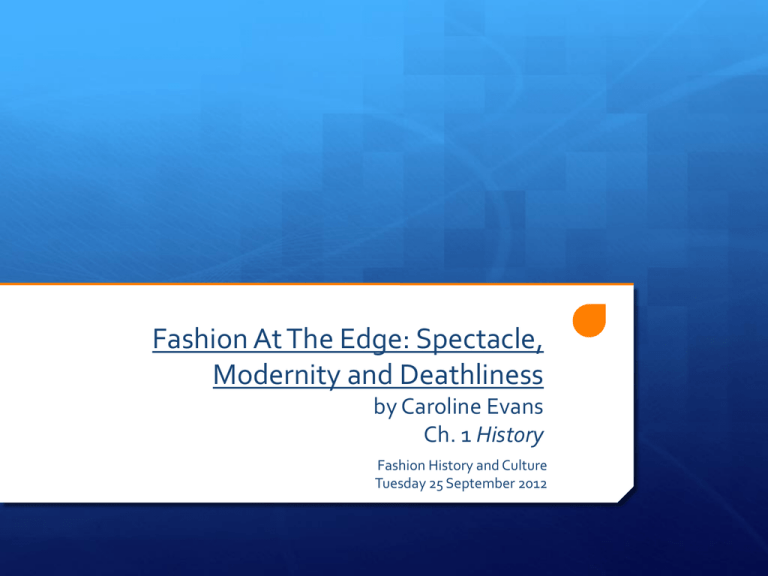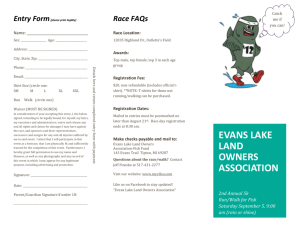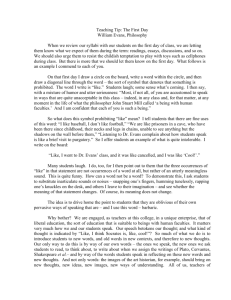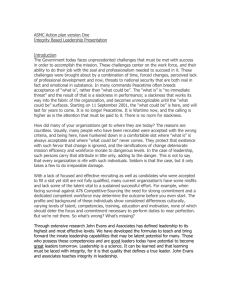Evans Ch. 1 History
advertisement

Fashion At The Edge: Spectacle, Modernity and Deathliness by Caroline Evans Ch. 1 History Fashion History and Culture Tuesday 25 September 2012 Response/Appraisal: the 2oth Century My grandchildren are all under the age of four, the first generation who will have no memories of the present (20th Century) century, and are likely to be appalled when they learn what was allowed to take place. For them, our debased entertainment culture and packagetour hedonism will be inextricably linked to Auschwitz and Hiroshima, through we would never make the connection, 20 J.G. Ballard, ‘Diary,’ 1999. Theory: Lynda Nead & Walter Benjamin Nead develops the idea of modernity of modernity as vitally and urgently engaged in a dialogue with its own historical conditions of existence so that “the modern” can never represent a clean break with the past; instead “modernity can be understood as a set of historical discourses and processes that are profoundly and necessarily caught up with the construction of the past,” Nead, Victorian Babylon: People, Streets and Images in Nineteenth-Century London, Evans 20. Walter Benjamin argued that “every image of the past that is not recognized by the present as one of its own concerns threatens to disappear irretrievably,” Illuminations, Evans 22. Corset, Underwear: Fluid symbols of bodily concerns across the decade. “In itself the corset’s range of the meanings were a microcosm of late twentieth-century fashion’s ability to draw creatively on its own past to recreate an image for the future, sketching conflicting fears and desires on the one body” Rebecca Arnold, Fashion, Desire and Anxiety: Image and Morality in the Twentieth Century, 66, in Evans, 24. “In the final decades of the twentieth century underwear as outerwear became a panacea for the fears surrounding sex and the body,” Ibid. Key people, terms: Vivienne Westwood, Martin Margiela, Rei Kawakubo, Olivier Theyskens, Walter van Beirendonck, Robert Cary-Williams. The flaneur Myself as The flaneur when shooting street fashion in Japan. Though the photographs and interviews that were made for NRT-KIX add unique value to the project as a whole, my own subjective impressions of menswear fashion in Tokyo and Osaka will invariably impact how the photographs and interviews, and even how the empirical research collected on economic conditions, will be interpreted. The idea of flanerie and the position of the flaneur is relevant here because what I attempted to do in Japan was to insert myself into the throngs of Shibuya and Harajuku to make myself more aware of the energies emanating from these places. Though the precise meaning of the flaneur has become associated with the circumstances of nineteenth-century Paris, and laterally with Western urban culture generally (Tester, 1994), the flaneur’s universally-agreed upon traits of disassociation and detachment from the relations and emotions of ordinary social existence describe aptly my own posture while in Japan. Disassociation, in addition to creating perceptual distance in order to gaze, is also essential to creating candid photographs. By pretending to be a lost tourist, who shoots everything in sight, though nothing and no one in particular, I found the license to violate people’s privacy, steal their face, leaving them with little possible recourse. For a month, I used naiveté to my advantage, to be a Westerner, effectively made invisible, whose follies and actions had to be overlooked and whose identity and memory ultimately dismissed. In sum, I became an Eastern flaneur, Willoughby 2000, 17-19. Charles Baudelaire said that “for the passionate observer it becomes an immense source of enjoyment to establish his dwelling in the throng, in the ebb and flow, the bustle, the fleeting and the infinite . . . .” (Baudelaire, 1972, p. 399). He continues, “the man who loves to lose himself in a crowd enjoys feverish delights that the egoist locked up in himself as in a box, and the slothful man like a mollusk in his shell, will be eternally deprived of” (Baudelaire, 1970). The egoist in this case is the Western ethnocentric, who exists in a state of self-imposed isolation from non-Western cultural forms. By joining city crowds and assimilating the style of “commotion,” the Western ethnocentric, begins to come out of his or her ego’s box, Ibid. Conceiving myself as a flaneur-like figure is helpful because both the 19th Century flaneur and I, as travellers in an urban environment, present problems of power relations. The flaneur in Paris has historically been depicted as a man who resides in a higher social class from those upon which he gazes and who obtained utility from the same (Tester, 1994). Often, circumstances involving prostitution and the commodification of the female body were present. My practice of photographing the Japanese public created explicit problems for my own subject-position. Photography has been cited as an important tool in the process of colonisation (Ramamurthy in Wells, Ed., 2000, et al). To suggest that my actions colonised the Japanese is hyperbolic at the least, though it is fair to say that I objectified and even fetishised a subject that was racially different than myself., Ibid. Historical Approach for Designers Central Saint Martins College of Art and Design, London Antwerp Academy, Antwerp, Belgium Dialectical Images “Parisian department stores of the second half of the nineteenth century staged oriental scenarios that eclectically mingled goods from different cultures and communities in a fantasy bazaar,” Rosalind H. Williams Dream Worlds: Ass Consumption in Late Nineteenth-Century France, 1982 in Evans, 29. Ringing Registers: Gary Hoover on American Retail According to Gary Hoover, UT Austin McCombs' entrepreneur-in-residence, retailing has a certain mystery about it. While it is known as being hard work, low profit and intensely competitive, the industry has spawned some of the world's largest companies and greatest fortunes. How can this be, in an industry which does not require highly technical expertise or advanced degrees, and that is not generally protected by patents and trade secrets? Hoover spoke about the history of the retail industry as part of his Story of Enterprise lecture series March 31 at the AT&T Executive Education and Conference Center. http://www.youtube.com/watch?v=XyC2GkzKTeM Key terms: montage & femme fatale “For Benjamin, the relationship between images of the past and the present worked like the montage technique of cinema. The principle of montage is that a third meaning is created by the juxtaposition of two images, rather than any immutable meaning inhering in each image. Benjamin conceived of this relationship as a dialectical one: the motifs of the past and the present functioned as thesis and antithesis,” Evans 33. “The femme fatale from the late nineteenth to early twentieth centuries, the cypher of desire and dread…” Evans 33. “(Galliano) by evoking the link between modernity, spectacle and consumption in the late nineteenth- and early twentieth-century city, he simultaneously brought it into the present by picturing the relationship between fashion, women, spectacle and commodification in the present,” Evans 2000. A few questions… How did Martin Margiela design a fashion metaphor to the consumer cycle of buying and discarding? Evans, 36. Do you agree that thanks to new communications, rising global affluence and, as a result, accelerated consumption “everything new and beautiful seems to arrive already haunted by its own demise? Evans, 38. Are we all, as Susan Sontag argues in On Photography, in the West “image-junkies”? Evans, 38. At the turn of the twenty-first century, are we still reeling from the previous century’s cultural trauma that has produced fragmented, episodic ‘reminiscences’ in contemporary culture like Sigmund Freud’s hysterics suffered at the turn of the twentieth century?



